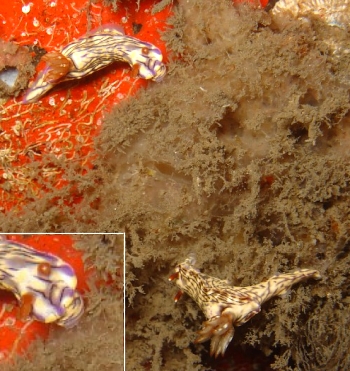Re: Hypselodoris zephyra feeding
September 2, 2008
From: N. Barbara Hanchard

Dear Bill,
Hypselodoris zephyra or H. nigrostriata? Sorry I couldn't quite follow the debate about the differentiation in gills (simple & triangular in cross section).
This is one of the other species found on the same wreck as my H. krakatoa was found on back in 2006. You will recall I said I found several other species all on the same site [message #21834 ].
Thought you might also like the photo of one of them laying eggs (least I hope they are eggs unlike my embarrassing error with H. batangas [#21833 ].
Locality: Tommy Chan Wreck, Ranadi, 35 meters, Honiara, Solomon Islands, Pacific Ocean, 12 January 2006, Wreck. Length: 35mm. Photographer: N.Barbara Hanchard.
Barbara
barbara.hanchard@ffa.int



Dear Barbara,
Yes this is definitely an egg ribbon. If you look carefully you can see the individual white eggs. Your photos also confirm that the greyish 'coating' the chromodorids are interested in is a sponge. In the enlarged inset I have added to your photo alongside, you can see the oral tube is extended in its feeding position. In your earlier photos with H. krakatoa I could not see any signs of a fibrous skeleton in the 'sponge' but in the enlargement [middle left photo] a distinct reticulate pattern of fibres is visible. It is similar to that in the dysideid sponge being eaten by H. zephyra in an earlier message [#19789].
I can't be 100% sure that the sponge is a dysideid, as the photo is not that clear, but it is what I would call 'a pretty good indication'. It is another example of how difficult it is to identify the food of some of these animals. Even if I had been there, I suspect the layer of sponge would have been too thin to make a confident field identification, and probably too thin to take a worthwhile sample for laboratory identification, for identifying this group of sponges which lack identifiable skeletal spicules, requires a sample which allows us to study the layers and arrangement of the fibre bundles, and in such a thin layer the structure of the colony would not have been developed sufficiently. I guess this give us another bit of evidence that H. krakatoa feeds on dysideid sponges, but we really need something a bit more concrete.
Concerning the difference between H. zephyra and H. nigrostriata. There seem to be two external characters separating them. In H. zephyra the black lines are said to be parallel while in H. nigrostriata they are often diagonal. Also the gills of H. nigrostriata are triangular in cross-section - that is if you cut a gill in half and looked at it end on it would be a triangle. This means that the whole gill is three-sided, the two sides facing inwards have gill leaflets on them while the side facing outwards is smooth with an orange line up each edge. In H. zephyra the gills are said to be 'simple' in that they only have two sides, each with gill leaflets. One edge of the gill faces in and the other faces out. There are a whole group of chromodorids with 'simple' gills like this. In the photos on the Forum of these two species, very few seem to have 'simple' gills. Even a photo of mine [#9445] which looks 'simple' could be triangular. In your photos, the gills are clearly triangular. More troubling is that one of your animals seems to have diagonal lines while the other has parallel lines. As I have said elsewhere on these pages I have trouble separating these species and am not 100% convinced they are two species. I have placed yours with H. zephyra, but I suspect I should be courageous and consider them to be a single species.
Best wishes,
Bill Rudman
Related messages
-
Re: Hypselodoris zephyra feeding
From: Barbara Hanchard, September 4, 2008 -
Re: Hypselodoris zephyra feeding
From: Philip Cromwell, November 23, 2007 -
Hypselodoris zephyra feeding
From: Erwin Kodiat, November 14, 2007 -
Re: Hypselodoris zephyra - feeding observations
From: David Mullins, November 13, 2007 -
Hypselodoris zephyra - feeding observations
From: Bruce Wilkie, April 2, 2007 -
Hypselodoris zephyra? from North Sulawesi
From: Jack Connick, May 29, 2006 -
Hypselodoris zephyra feeding
From: Erwin Kodiat, December 19, 2005 -
Hypselodoris zephyra on the Sunshine Coast
From: Gary Cobb, December 3, 2003 -
Re: Hypselodoris nigrostriata from Bali
From: Phil Cromwell, March 21, 2003 -
Hypselodoris zephyra off North Queensland
From: Mikkel Mowinckel, March 21, 2003 -
Hypselodoris zephyra from northern New South Wales (1)
From: Bill Rudman, March 21, 2003 -
Hypselodoris zephyra from northern New South Wales (2)
From: Bill Rudman, March 21, 2003 -
Hypselodoris zephyra from Vanuatu
From: Vinka Stenhouse, February 14, 2003 -
Hypselodoris zephyra from Indonesia
From: Alice Lee, January 22, 2003 -
Hypselodoris zephyra from South Japan
From: Mizuho, January 24, 2001 -
Hypselodoris zephyra from Vanuatu
From: Vinka Stenhouse, March 22, 2000
